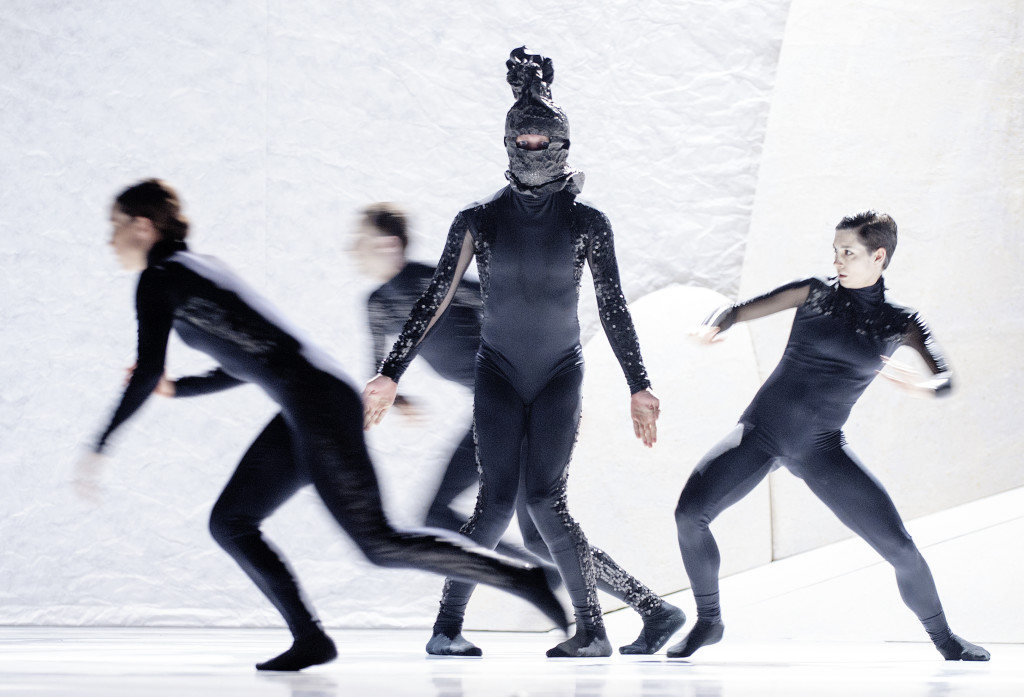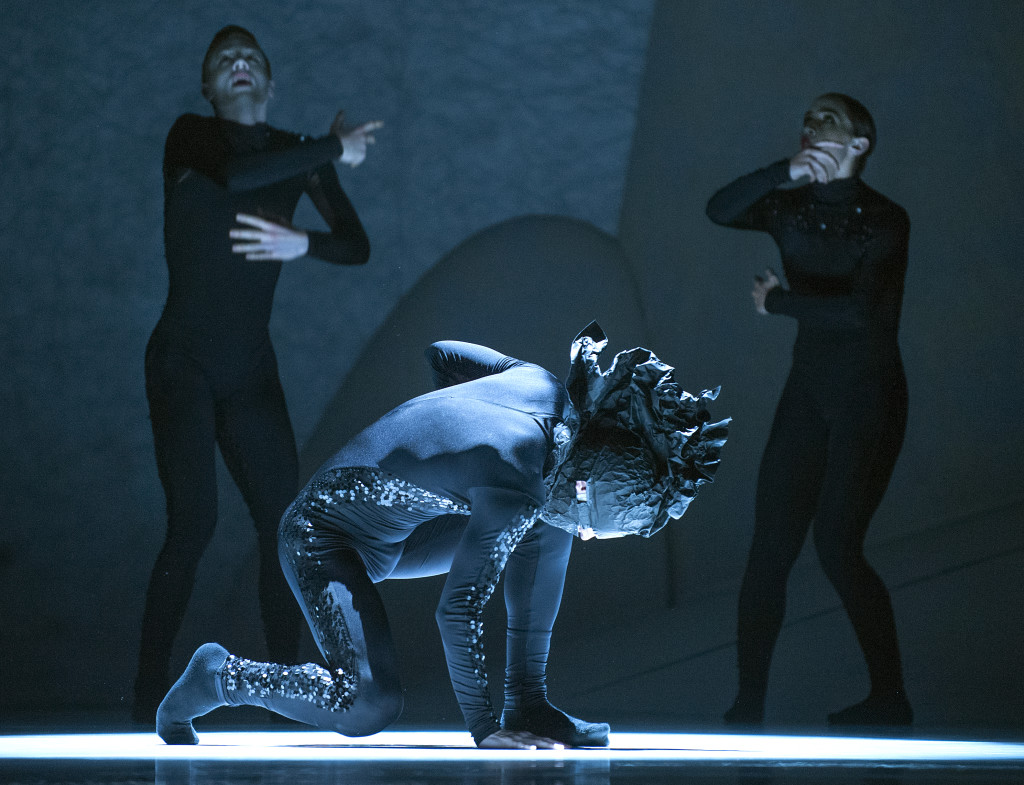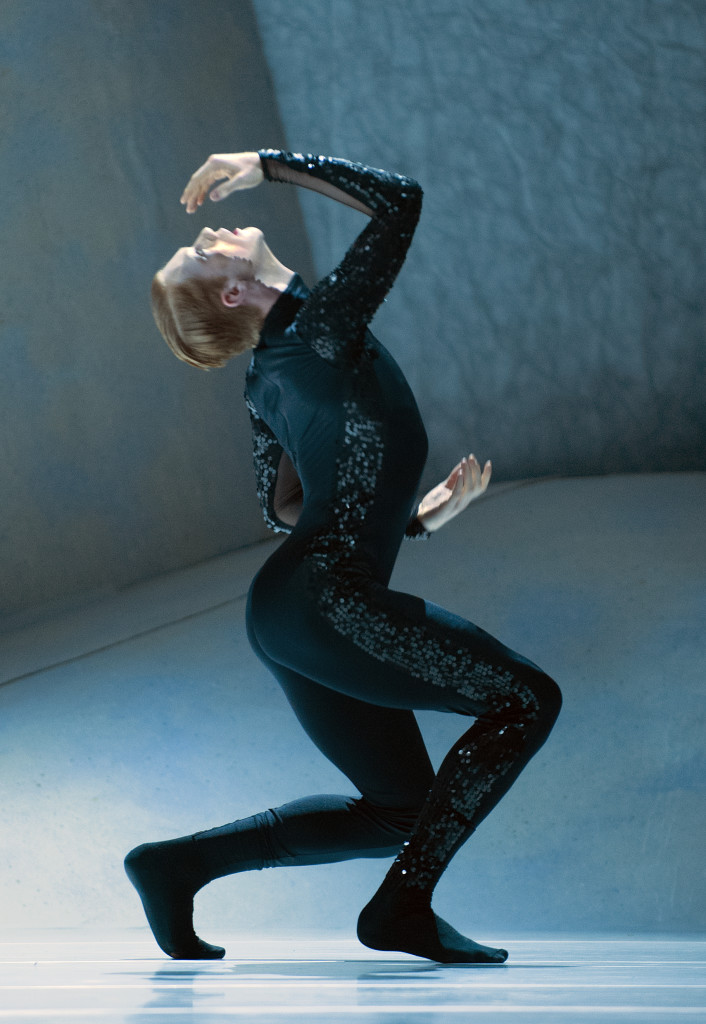
Ballet BC performs one of the most scandalous ballets of the 20th century, for the close of their fantastic 2014/2015 Season, and does not disappoint one bit. The Rite of Spring has said to have induced riots when it premiered at the Théâtre des Champs-Elysées in 1913. Dealing with paganism and human sacrifice, alongside music that broke all the rules, The Rite of Spring was a rough pill to swallow for audiences of that time. For today’s audiences however, for whom shock is a welcome emotion, it serves as a perfect fit. Ballet BC’s beautiful dancers bring Stravinsky’s strange, agrarian vision to life in an updated, modern setting. RITE runs from May 7th to the 9th, 8pm, at the Queen Elizabeth Theatre in downtown Vancouver.
The show begins with A Shadow, the village elder, prophesizing about the village. With elaborate headgear that is almost reptilian and a black glittering bodysuit, the Shadow is immediately authoritative. As Young Girls flood the stage to perform The Dance of Abduction and The Spring Rounds, they too are dressed in black snakeskin-like bodysuits. Together the dancers look like alien beings dancing on a faraway planet.
Choreographer Emily Molnar describes her vision as building “a new language that speaks to a moment of transformation in an afterworld”. The set is simple, and devoid of color. A wooden tree with leaves resembling table tennis paddles dominates the left side of the stage. Bald conical hills on the right side personally evoked in me the futuristic plains of Dali’s “Persistence of Memory”, where space and time were bent beyond the present, much like in an “afterworld”. Molnar takes the Russian pagan theme to what seems to be an outer space, extraterrestrial one. The result is a streamlined, sophisticated setting. This society appears to be free of our own societal demands. These villagers only pay heed to their most basic obligations- to the earth and to their basest of instincts.

The choreography is modern. It oscillates between painfully slow, in order to introduce characters and settings, and all the way to leaping and bounding spectacles, to demonstrate joy at times and turmoil at others. The lines of the dancers are angular and they frequently assemble in group-poses with their limbs held out at geometric angles. The spotlight catches these collective poses and throws almost perfectly intricate shadows around the stage. The dancers’ movements are almost reminiscent of vogueing. The dances, although based in traditional ballet, push the traditional boundaries. Novel moves such as exaggerated sighing, shrugging and “throwing” of arms and legs (almost like wacking), take the originally anti-traditional play up a few notches on the rebellion scale. The first part of the show is dark and smooth with the dancers performing sharp movements that are all edges and corners.
Stravinsky’s music can get challenging to absorb at times, especially when it is reduced to a stretched out insect call for minutes on end. However this silence amplifies the highs through the roof when they do occur. Strobe lights accompany The Shadow as he dances in a clean-cut circle of light. Heavy contemporary beats intensify his energetic dance even further, creating an electric performance that jolts. Molnar balances the lows with the highs and we come away with just the right level of stimulation. Her interpretation of The Rite of Spring is extremely creative. She forces you to consider Stravinsky’s work in a modern light and to recognize its relevance in today’s society, where we lack connection with our communities and nature. The first part ends spectacularly with Dance of the Earth, where all the anticipation built up through the slower moving parts of the show, burst into fireworks as the dancers dance together with perfect rhythm and at their full energies.

After the intermission, the second part of RITE, Consagracion, is a complete 180 on its predecessor. This part of the ballet shows the village choosing a Young Girl so that she can perform the Sacrificial Dance and dance herself to death. This is where the shocking paganism really kicks in. Gone are the black, glittering, second-skin bodysuits. In their stead are white nightdresses that children wear. The large tree and hills are replaced by three giant baskets that get lifted progressively through the show. The dancers now embody the Young Girls more clearly. The choreography is now helmed by Gustavo Ramirez Sansano. He looks at the coming of age of the Young Girls, until one of them gets picked for the sacrifice. Sansano focuses on the changes experienced through puberty, and the act of “outgrowing clothes and bodies”.
The dances here are full of “anticipation and exhilaration”. The focus shifts from the relationship of the community with the earth, to the relationship between the Young Girls and their youth. Movements become more traditional. Everything is rounded and light. The Young Girls appear to be sleepwalking in confusion, trying to resist change but eventually giving in. Old Wise Men engage the chosen Young Girl in a dance of what appears to be seduction and submission. The last two dances are performed by duos to demonstrate this seduction. The dancers engage in a beautiful reactive play of bodies as one gradually erodes the resolve of the other. The softness and organic quality of the second part of the show is refreshing after the rigid angles of the first. Order and masculinity in the first half are complimented by the free-form and femininity of the second. The two parts wholly complement each other and produce a fulfilling ensemble piece. Just as the dancers thrive in the first part, they perform their magic in the second, with lines that are more curved than straight. They let their emotions run wild as opposed to their restrained and intense emotions in the first part. The white childhood dresses eventually come off and the dancers dance in minimal clothing to signify puberty. We see the tautness and ripples of the dancers’ muscles and get an incredibly honest to the bone performance from them. Quite literally.
RITE is the right sort of bang that Ballet BC chose to end their season with. It embodies the company’s continual desire to contemporize and embolden classic works and dance traditions. This version of The Rite of Spring adds to the original work and contemporizes it relevantly. For first-time ballet goers, RITE might prove to be slightly challenging but for lovers of dance there is not much here that will disappoint. This ballet is fresh and thought provoking. A bold project!
For Tickets see http://www.ticketmaster.ca/Ballet-BC-tickets/artist/54683
-Prachi Kamble
